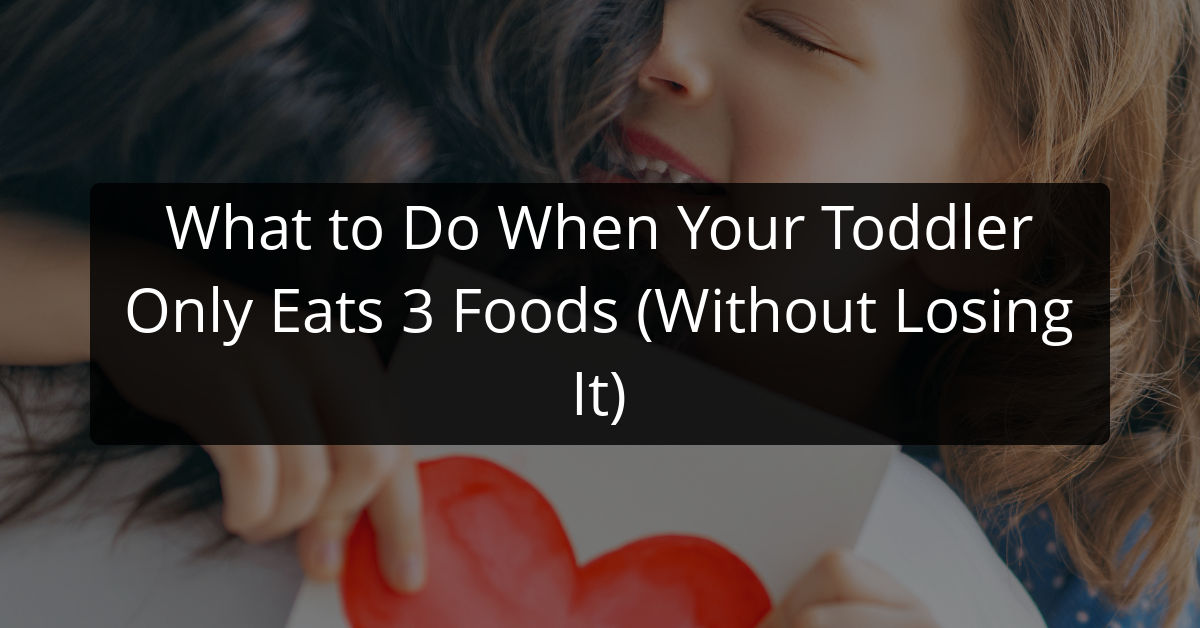What to Do When Your Toddler Only Eats 3 Foods (Without Losing It)

When your toddler only eats three foods, it’s normal to feel frustrated, but remember that food preferences are part of their development. Embrace their favorites for comfort and introduce new foods alongside them without pressure. Show enjoyment of diverse foods during family meals and involve them in meal prep to spark interest. Consistent exposure may lead to gradual acceptance. By fostering a supportive eating environment, you can guide your child towards more adventurous meals. Discover more strategies to support this journey.
Key Facts Summarized
- Introduce new foods alongside familiar ones to reduce intimidation and increase acceptance.
- Offer repeated exposure to new foods, as acceptance may take 8 to 15 tries.
- Involve toddlers in meal preparation to spark interest in trying new foods.
- Maintain a pressure-free mealtime environment to encourage exploration without stress.
- Focus on weekly food variety and intake rather than daily consumption.
Embrace Their Favorites and Expect Changes
While it might feel exasperating when your toddler repeatedly requests the same meals, it’s important to embrace their favorites and expect changes.
Understand that these food preferences are part of their developmental journey. Toddlers often cling to familiar favorites, but they’ll eventually explore new foods at their own pace.
Aim to introduce a variety of foods without pressure, focusing on their overall weekly consumption rather than daily intake. Encourage healthy options by maintaining a routine that includes repeated exposure to different foods.
It may take 8 to 15 introductions for them to accept new tastes. By remaining patient and supportive, you nurture their growing palate and help them build a positive relationship with food, fostering lifelong healthy eating habits.
Offer New Foods Alongside Familiar Ones
Understanding your toddler’s favorite foods is an important part of fostering their healthy eating habits, but there’s also an opportunity to gently expand their palate. Offer new foods alongside familiar favorites to reduce intimidation and encourage exploration.
Toddlers often find comfort in known flavors, so consistent pairing is key. Research shows that it can take 8 to 15 exposures before a toddler eats new foods willingly. Serve small portions of new items with larger portions of familiar ones to prevent overwhelm.
Involve your toddler in meal preparation––it enhances their interest and makes them more likely to try what they’ve helped create. Maintain a positive mealtime environment, free of pressure, to foster acceptance and exploration of different flavors.
Model Positive Eating Habits
To foster healthy eating habits in your toddler, it’s essential to model positive eating behaviors yourself. By consistently enjoying a variety of foods, you show your toddler that trying new foods can be a pleasant experience.
During family meals, create a supportive environment where positive feelings around food flourish. This encourages toddlers to explore different tastes without pressure. Reinforce mealtime positivity by calmly savoring both new dishes and familiar favorites, demonstrating that all foods deserve a chance.
Your toddler is more likely to mimic your openness to diverse foods when they see you genuinely enjoying them. Remember, your actions speak volumes—by modeling positive eating habits, you set the foundation for lifelong healthy eating patterns and encourage toddlers toward adventurous eating.
Frequently Asked Questions
What to Do if My Toddler Barely Eats?
If your toddler barely eats, track their food intake over a week to notice patterns.
Offer small portions of new foods with their favorites, fostering a no-pressure environment.
Keep a consistent meal schedule so they learn hunger cues.
Involve them in meal prep to ignite interest.
If distress persists, reach out to a pediatrician or feeding specialist.
You’re nurturing their growth, and your patience makes a difference.
What Are Signs of Autism in Toddlers With Food?
You might notice signs of autism in toddlers through their eating habits.
Watch for strong preferences for specific textures, aversions to certain tastes or smells, and repetitive behaviors like insisting on the same meals.
They may avoid social interactions during meals.
If your toddler consistently resists trying new foods and has a restricted diet, consult a pediatrician.
Understanding these signs helps you better support their unique needs.
When to Worry About Toddler Loss of Appetite?
When your toddler’s appetite disappears like a magician’s trick, it’s time to pay attention.
Don’t wait if they’re losing weight or struggling to gain. If mealtime battles become emotional storms or they shy away from new textures, reach out to a feeding specialist.
Also, if appetite changes come with developmental or behavior shifts, consult a healthcare professional.
Your vigilance can ensure your little one thrives and grows healthily.
Why Does My Toddler Keep Wasting Food?
Your toddler’s wasting food might be due to their developing portion control and fluctuating taste preferences. They’re still learning about hunger cues, often misjudging how much they can eat.
Engage them in meal prep to spark interest in trying new foods. Offer smaller portions initially, letting them ask for seconds if needed.
This approach respects their development while minimizing waste and encourages their participation in making meal times more enjoyable.
Conclusion
Remember, you’re not alone in navigating your toddler’s picky eating. Keep embracing their favorite foods while patiently introducing new options. Isn’t it worth the effort to create a positive mealtime environment that encourages curiosity and growth? By modeling healthy eating habits yourself, you set a powerful example. Trust in the process and stay consistent. Your persistence, coupled with empathy and understanding, will gradually expand their palate and make mealtime a more enjoyable experience for everyone.


Leave a Comment